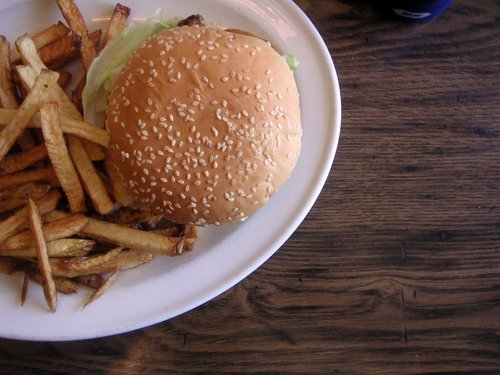The Environmental Impact of the Global Hamburger Industry
Ah, the hamburger. It’s a global icon, a symbol of fast food culture, and for many of us, a source of pure, unadulterated culinary joy. I’ve spent countless hours exploring burger joints worldwide, appreciating the craft and culture behind this seemingly simple food. But as much as I adore a perfectly cooked patty, we can’t ignore the environmental shadow cast by the global hamburger industry. Its journey from farm to bun involves a complex web of resources and processes, demanding a closer look at the true environmental cost of our collective burger obsession, especially considering Americans alone consume an estimated 10 billion burgers annually, according to the World Resources Institute.
The heavy environmental hoofprint of beef
The heart of the matter, quite literally, is the beef patty. While delicious, beef production is notoriously resource-intensive, placing significant strain on our planet. Let’s break down the key impacts.
Land use demands
Raising cattle for beef demands vastly more space compared to other common proteins. A study found that beef requires approximately 28 times more land than pork or chicken production. The difference becomes even more stark when compared to staple plant foods like potatoes or rice, with beef needing upwards of 160 times more land per calorie. This intensive land use often drives deforestation, particularly in ecologically sensitive regions like the Amazon rainforest, where forests are cleared for cattle grazing and to grow feed crops like soy, as detailed in analyses by Carbon Brief. This clearing releases massive amounts of stored carbon, accelerating climate change, and destroys habitats crucial for biodiversity. There’s also a significant ‘carbon opportunity cost’ – the potential carbon sequestration lost when land is used for agriculture instead of being allowed to return to its natural state, like forest, as discussed by Peter Singer via The Conversation. While nuances exist – well-managed grazing in specific ecosystems like the North American Great Plains can sometimes mimic historical bison patterns and help conserve native grasslands, as researchers note – the dominant global trend links beef production to significant land degradation and biodiversity loss.
Water consumption
Water usage is another critical factor. Beef production consumes substantial amounts of water, including rainwater for feed crops (green water), surface and groundwater for irrigation and drinking (blue water), and water polluted during production (grey water). The same Live Science study highlighted that beef requires about 11 times more irrigation water than poultry or pork. The blue and grey water footprints are particularly concerning for animal products like beef, as pointed out in research discussing food sustainability assessments (MDPI). This massive water demand contributes significantly to water stress in many agricultural regions around the world.
Greenhouse gas emissions
Then there are the greenhouse gases (GHG) warming our planet. The hamburger industry, fueled by beef, is a major contributor. Food animal production overall accounts for a substantial portion of global emissions, estimated between 14.5% and 15% (PMC, MIT Technology Review). Beef is a primary driver within this. Cattle, being ruminants (animals like cattle that digest food in a specialized stomach compartment), naturally produce methane during digestion – a greenhouse gas significantly more potent than carbon dioxide, especially over shorter timescales. Add to that the nitrous oxide released from fertilizers used on pastures and feed crops (itself a potent GHG), and the CO2 from energy used throughout the supply chain. Interestingly, as highlighted in The Conversation, the transport of beef accounts for only about 0.5% of its emissions; the overwhelming majority (99.5%) comes from the farming process itself, including land use changes and feed production. The scale is immense: one kilogram of beef can generate emissions equivalent to roughly 100 kilograms of CO2, though this varies with farming practices.
Looking beyond the patty at buns and alternatives
While beef often takes center stage in environmental discussions, other burger components also play a role. It’s worth considering the bun and the rise of alternative patties.
The impact of the bun
Take the humble bun. As outlined by FoodPrint, most standard buns use conventionally grown wheat, frequently cultivated in vast monocultures. This practice, focusing on a single crop over large areas, can deplete soil health, reduce biodiversity by eliminating habitat variety, and often increases reliance on chemical fertilizers and pesticides, which have their own environmental footprints. Opting for buns made from organic wheat, or even better, heritage grains like spelt or rye, can lessen this impact by supporting more diverse farming systems and reducing chemical inputs. Even toppings and condiments, while individually small, contribute to the overall footprint through their production, processing, and transport energy.
Plant-based alternatives and their supply chains
The rise of plant-based burgers offers a seemingly greener path, and generally, they are far less resource-intensive than beef. However, they aren’t entirely without environmental considerations. As Vox points out, popular brands like Impossible Foods and Beyond Meat often rely on ingredients like coconut oil and cacao butter to achieve that desirable meaty texture and melt. The surging demand for these plant-based options creates new pressure on tropical regions like Southeast Asia and West Africa, where much of these oils are produced. Concerns exist that if companies prioritize low costs over ethical sourcing, this demand could inadvertently contribute to deforestation, unsustainable farming practices, or poor labor conditions in areas with potentially weak environmental regulations and protections. Climate change itself also threatens the production of these key ingredients, impacting farmers in vulnerable regions. It serves as a reminder that sustainability requires careful examination across the entire supply chain, even for alternatives designed to be better for the planet.
Forging a path to a more sustainable burger
So, faced with these impacts, what can be done? Thankfully, there are numerous paths forward, ranging from consumer awareness to innovative food technologies and better farming.
Raising consumer awareness
Awareness is a powerful first step. Studies reported by Johns Hopkins and discussed on Phys.org demonstrate that simple climate impact labels on fast-food menus can significantly sway consumer choices. When diners see a ‘high climate impact’ label next to a beef burger, they become considerably more likely (a 23% increase in one study) to choose a lower-impact option like chicken or a plant-based patty. This highlights the power of information in nudging behavior towards sustainability. It also connects to findings from research using data from the National Health and Nutrition Examination Survey (NHANES) (University of Michigan), which surprisingly found that people cooking more frequently at home sometimes had higher dietary carbon footprints. This wasn’t because home cooking is inherently bad, but because those individuals tended to eat significantly more meat overall. It underscores a crucial point: what we eat often matters more for climate impact than where we eat it.
Dietary shifts and blended burgers
Reducing meat consumption doesn’t necessarily mean giving up burgers entirely. Simple strategies like choosing smaller patties or enjoying beef burgers less frequently can collectively make a difference. One particularly exciting development, in my opinion, is the ‘blended burger’. Championed by the World Resources Institute, this involves replacing a portion of the beef – say, 30% – with mushrooms or other plant-based ingredients. This relatively small change yields remarkable environmental benefits: potentially slashing annual greenhouse gas emissions by an amount equivalent to taking over 2.3 million cars off US roads, saving billions of gallons of water (83 billion gallons annually, per WRI), and freeing up vast tracts of agricultural land (an area larger than Maryland). Plus, as culinary experts and taste tests confirm, blended burgers can be just as delicious and satisfying, often boasting lower calories and fat, and a pleasing umami flavor (The Conversation). It’s a practical, palatable step gaining traction in schools, universities, and even some fast-food chains.
Exploring alternative proteins
Beyond blending, the world of alternative proteins is rapidly expanding. Fully plant-based burgers from brands like Impossible and Beyond offer a dramatically lower environmental footprint compared to conventional beef, as confirmed by multiple analyses (Carbon Brief). A significant Oxford study highlighted by The New York Times found vegan diets were associated with 75% lower greenhouse gas emissions, 75% less land use, and 54% less water use compared to high-meat diets. While plant-based supply chains need scrutiny, their overall impact remains significantly lower. Then there’s cultivated or lab-grown meat, discussed by the NYT and MIT Technology Review. The promise is immense: real meat grown from animal cells, potentially slashing emissions, land use, and water needs associated with traditional livestock farming. However, the technology is still developing. Significant challenges remain in scaling up production efficiently, reducing costs, and ensuring the energy used in the process is primarily renewable to realize the full climate benefits. It’s definitely a space I’m watching with keen interest!
Improving farming practices
Improving traditional farming practices also plays a crucial role. Shifting away from intensive industrial systems towards methods like certified grass-fed ranching, regenerative agriculture (farming practices focused on rebuilding soil health and ecosystem function), or organic farming can certainly lessen the environmental impact per burger, as FoodPrint suggests. These approaches often focus on enhancing soil health, improving animal welfare, reducing chemical use, and integrating practices like rotational grazing or silvopasture (integrating trees and grazing livestock on the same land). While these are positive and necessary steps, some environmental researchers offer a sobering perspective. Joseph Poore from the University of Oxford, cited in the Peter Singer article (The Conversation), argues compellingly that the environmental benefits gained from even the most ‘sustainable’ animal agriculture often pale in comparison to the impact reduction achieved by significantly cutting down or eliminating animal product consumption altogether. He suggests adopting a vegan diet is ‘the single biggest way’ an individual can reduce their impact across multiple environmental metrics. This highlights a complex tension: improving existing systems is vital, but fundamental dietary shifts may offer the most profound environmental gains.
Rethinking our relationship with the burger
The hamburger holds a special place in global food culture; it’s a culinary icon, synonymous with comfort, convenience, and celebration across the world. But as we’ve explored, its immense popularity, particularly its reliance on resource-intensive beef, comes at a significant environmental cost. Peter Singer’s stark warning that we might be ‘gambling with the future of our planet for the sake of hamburgers‘ resonates deeply. It forces us to confront the potential disconnect between our everyday food choices and their far-reaching consequences on climate change, deforestation, water resources, and biodiversity.
This exploration isn’t intended to demonize the burger or induce guilt with every bite. As a burger enthusiast myself, I understand the appeal! Instead, it’s an invitation to become more mindful consumers. Understanding the journey of our food – the land, water, energy, and emissions embodied in that patty, bun, and toppings – empowers us to make more informed decisions. Perhaps that means embracing the blended burger more often, trying some of the impressive plant-based options now available, seeking out beef from local farms employing regenerative practices, or simply savoring that classic beef burger as an occasional treat rather than a frequent meal. Every choice, multiplied across billions of consumers, contributes to a larger picture. By rethinking our relationship with this beloved food, exploring innovations, and supporting sustainable practices, we can collectively help steer the future of the hamburger – and crucially, our planet – towards a more sustainable, and hopefully still delicious, path.






 . She ascribes the main contribution to Louis Lassen, a Danish immigrant who owned Louis’ Lunch, a New Haven dinner. More claims around its invention revolve around Fletcher Davis, Oscar Weber Bilby, Charlie Nagreen, Frank, and Charles Menches. According to White Castle, the famous American hamburger chains, more reliable traces of the origin are found in Germany, and Otto Kuase might be the actual name behind the invention.
. She ascribes the main contribution to Louis Lassen, a Danish immigrant who owned Louis’ Lunch, a New Haven dinner. More claims around its invention revolve around Fletcher Davis, Oscar Weber Bilby, Charlie Nagreen, Frank, and Charles Menches. According to White Castle, the famous American hamburger chains, more reliable traces of the origin are found in Germany, and Otto Kuase might be the actual name behind the invention.

 5. The most expensive hamburger ever sold was the FleurBurger5000. It was a combination of Kobe beef, foie gras and black truffles. The Las Vegas branch of Fleur de Lys sold the burger at £4,233.
5. The most expensive hamburger ever sold was the FleurBurger5000. It was a combination of Kobe beef, foie gras and black truffles. The Las Vegas branch of Fleur de Lys sold the burger at £4,233.
 The origin of the hamburger can also be traced back to rundstuck warm, a popular pork burn like bread. Some people call it the
The origin of the hamburger can also be traced back to rundstuck warm, a popular pork burn like bread. Some people call it the 
 The joint was famous for its signature hamburgers. Walt A. Anderson and Edgar Waldo Billy Ingram were the super brains behind the opening of the White Castle in 1921. The first restaurant was in Kansas, which was created to change people’s
The joint was famous for its signature hamburgers. Walt A. Anderson and Edgar Waldo Billy Ingram were the super brains behind the opening of the White Castle in 1921. The first restaurant was in Kansas, which was created to change people’s 

 ion rings as big as doughnuts.
ion rings as big as doughnuts.

 the meal.
the meal.
 First, it is like having everything you want in one bite. A hamburger comes in different shapes, sizes and ingredients. From buffalo burgers to chicken and even tuna, people have too much to choose from. One burger has a steak, some veggies, cheese and tomatoes. If you buy it at a great restaurant, you might get an extra side plate of fries.
First, it is like having everything you want in one bite. A hamburger comes in different shapes, sizes and ingredients. From buffalo burgers to chicken and even tuna, people have too much to choose from. One burger has a steak, some veggies, cheese and tomatoes. If you buy it at a great restaurant, you might get an extra side plate of fries.